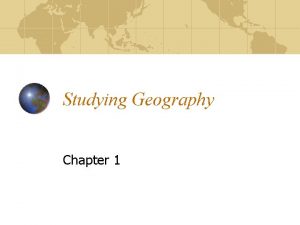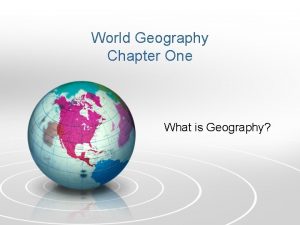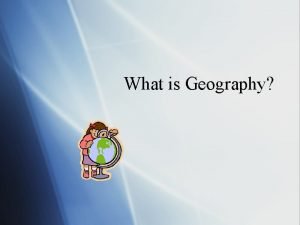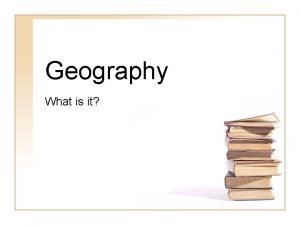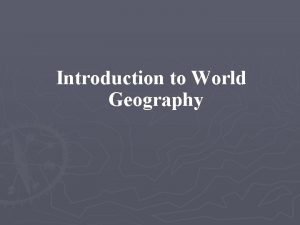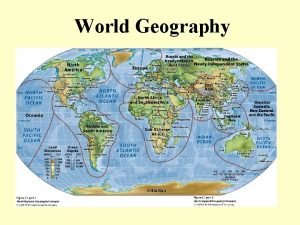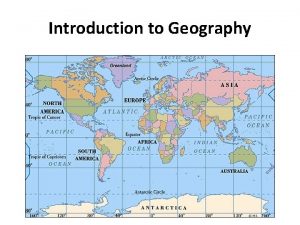Chapter 1 Geography What is Geography Geography The
















- Slides: 16

Chapter 1 Geography

What is Geography? Geography: The science of studying Earth as the home of humans. Geography helps us: -Understand the world in spatial terms -Understand places and regions -Understand Earth’s physical systems -Understand the human systems of Earth -Understand environment and society -Understand the uses of geography

Location, Location How do we tell where a place is? How do you give directions to people? Relative location: describes where a place is located compared with other places. (I live in between Chick-Fil-A and Wal-Mart) What is Georgia’s relative location? Absolute location: identifies a precise position on Earth’s surface. (River Trail Middle School is located at 10795 Rogers Cir, Johns Creek, GA 30097)

The Globe The earth is a sphere and can be divided into hemispheres.

The Globe The equator divides the earth into the North and South hemisphere. The prime meridian divides the earth into the West and East Hemisphere.


Geographic Regions of Georgia is divided into five geographical regions. -Appalachian Plateau -Ridge and Valley -Blue Ridge -Piedmont -Coastal Plain

Geographic Regions of Georgia 1. Appalachian Plateau -Smallest region - “TAG” corner: where Tennessee, Alabama, and Georgia meet. -Caves, deep canyons, and rock formations -Contains part of the Appalachian Trail

Geographic Regions of Georgia 2. Ridge and Valley -Between the Appalachian Plateau and Blue Ridge Mountains -Low, open valleys and narrow ridges (a long narrow hilltop, mountain range) -Known for carpet manufacturing -Contains part of the Appalachian Trail

Geographic Regions of Georgia 3. Blue Ridge - Highest and largest group of mountains in Georgia - Contains the highest peak in the state: Brasstown Bald

Geographic Regions of Georgia 4. Piedmont -Gently sloping hills and valleys in the north and flatlands in the south. -Half of the state’s population lives here

Geo. Graphic Regions of Georgia 5. The Coastal Plain -The largest region -Major agricultural region of the state -Low flat plains and wetlands

The Fall Line is the point at which hilly or mountainous lands meet the coastal plain.

Climate vs weather Weather and Climate Are Not The Same! • Weather is condition and temperature of atmosphere - can change day to day, season to season • Climate is average weather condition over long period of time. Many people and businesses move to Georgia because of the climate.

Climate vs weather Weather • Georgia’s weather affected by winds blowing west to east • Winter: fronts can cause snow, rain; sharp, fast temperature changes • Summer: warm moist fronts from the Gulf of Mexico affect weather • Clouds, heavy rain, and thunderstorms may occur as warm air cools

Climate vs weather Climate • Georgia is in warm temperate subtropical zone; warm year-round. Climate is best described as warm and moist • Hot summers, precipitation in form of rain • Cooler winters, temperature varies by elevation and latitude
 Hình ảnh bộ gõ cơ thể búng tay
Hình ảnh bộ gõ cơ thể búng tay Frameset trong html5
Frameset trong html5 Bổ thể
Bổ thể Tỉ lệ cơ thể trẻ em
Tỉ lệ cơ thể trẻ em Gấu đi như thế nào
Gấu đi như thế nào Thang điểm glasgow
Thang điểm glasgow Chúa sống lại
Chúa sống lại Các môn thể thao bắt đầu bằng từ đua
Các môn thể thao bắt đầu bằng từ đua Thế nào là hệ số cao nhất
Thế nào là hệ số cao nhất Các châu lục và đại dương trên thế giới
Các châu lục và đại dương trên thế giới Công của trọng lực
Công của trọng lực Trời xanh đây là của chúng ta thể thơ
Trời xanh đây là của chúng ta thể thơ Cách giải mật thư tọa độ
Cách giải mật thư tọa độ Phép trừ bù
Phép trừ bù độ dài liên kết
độ dài liên kết Các châu lục và đại dương trên thế giới
Các châu lục và đại dương trên thế giới Thơ thất ngôn tứ tuyệt đường luật
Thơ thất ngôn tứ tuyệt đường luật



















